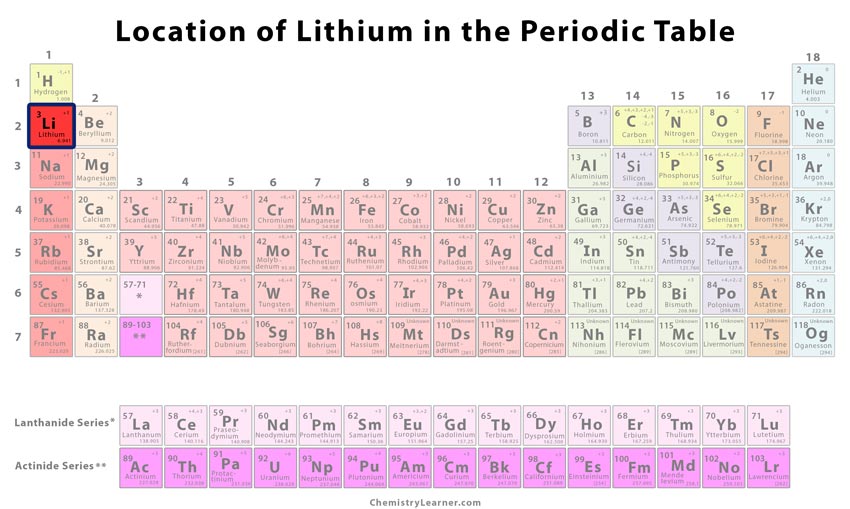2020-11-21 by Nick Connor Atomic Radius of Lithium The atomic radius of Lithium atom is 128pm (covalent radius). 2020-11-21 by Nick Connor Atomic Radius of Lithium The atomic radius of Lithium atom is 128pm (covalent radius). The atomic number of lithium the first element in group 1, is 3. The atomic number of the second element in this group.
- Atomic Number Of Lithium 6
- What Is The Atomic Number Of Lithium
- Atomic Number Of Lithium 7
- Atomic Number Of Lithium 6
- Atomic Number Of Lithium Ion
Chemical properties of lithium - Health effects of Lithium - Environmental effects of Lithium
|

LithiumLithium is the first of the alkalis in the periodic table. In nature it’s found like a mixture of the isotopes Li6 and Li7. It’s the lightest solid metal, it’s soft, silvery-white, with a low melting point and reactive. Many of its physical and chemical properties are more similar to those of the alkaline earth metals than to those of its own group. Between the most significant properties of lithium we find its high specific heat (calorific capacity), the huge temperature interval in the liquid state, high termic conductivity, low viscosity and very low density. Metallic lithium is soluble in short chain aliphatic amines, like etilamine. It’s insoluble in hydrocarbons. Applications The main lithium compound is the lithium hydroxide. It’s a white powder; the manufactured material is monohydrate lithium hydroxide. The carbonate can be used in the pottery industry and in medicine as an antidepressant. The bromine and the lithium chloride both form concentrated brine, which have the property of absorbing the humidity in a wide interval of temperature; these brines are used in the manufactured air conditioning systems. Lithium in the environment Like all alkali metals, lithium reacts easily in water and does not occur freely in nature due to its activity, Lithium is a moderately abundant element and its present in The Earth’s crust in 65 ppm (parts per million). This situates lithium below nickel, copper, and tungsten and over cerium and tin, referring to abundance. Health effects of LithiumEffects of exposure to Lithium: Fire: Flammable. Many reactions may cause fire or explosion. Gives off irritating or toxic fumes (or gases) in a fire. Explosion: Risk of fire and explosion on contact with combustible substances and water. Inhalation: Burning sensation. Cough. Laboured breathing. Shortness of breath. Sore throat. Symptoms may be delayed. Skin: Redness. Skin burns. Pain. Blisters. Eyes: Redness. Pain. Severe deep burns. Ingestion: Abdominal cramps. Abdominal pain. Burning sensation. Nausea. Shock or collapse. Vomiting. Weakness. Effects of short-term exposure:The substance is corrosive to the eyes, the skin and the respiratory tract. Corrosive on ingestion. Inhalation of the substance may cause lung oedema. The symptoms of lung oedema often do not become manifest until a few hours have passed and they are aggravated by physical effort. Rest and medical observation is therefore essential. Immediate administration of an appropriate spray, by a doctor or a person authorized by him/her, should be considered. Routes of exposure:The substance can be absorbed into the body by inhalation of its aerosol and by ingestion. Inhalation risk:Evaporation at 20°C is negligible; a harmful concentration of airborne particles can, however, be reached quickly when dispersed. Chemical dangers:Heating may cause violent combustion or explosion. The substance may spontaneously ignite on contact with air when finely dispersed. Upon heating, toxic fumes are formed. Reacts violently with strong oxidants, acids and many compounds (hydrocarbons, halogens, halons, concrete, sand and asbestos) causing fire and explosion hazard. Reacts violently with water, forming highly flammable hydrogen gas and corrosive fumes of lithium hydroxide. Environmental effects of LithiumMetallic lithium will react with nitrogen, oxygen, and water vapor in air. Consequently, the lithium surface becomes coated with a mixture of lithium hydroxide (LiOH), lithium carbonate (Li2CO3), and lithium nitride (Li3N). Lithium hydroxide represents a potentially significant hazard because it is extremely corrosive. Special attention should be given to water organisms. Read more on lithium in water Back to the periodic table of elements. |
More from 'Elements'
Lenntech (European Head Office)
Atomic Number Of Lithium 6

Distributieweg 3
2645 EG Delfgauw
The Netherlands
Phone: +31 152 610 900
fax: +31 152 616 289
e-mail: info@lenntech.com

Lenntech USA LLC (Americas)
5975 Sunset Drive
South Miami, FL 33143
USA
Phone: +1 877 453 8095
e-mail: info@lenntech.com
Lenntech DMCC (Middle East)
Level 5 - OFFICE #8-One JLT Tower
Jumeirah Lake Towers
Dubai - U.A.E.
Phone: +971 4 429 5853
e-mail: info@lenntech.com
What Is The Atomic Number Of Lithium
Copyright © 1998-2021 Lenntech B.V. All rights reserved
Lithium: isolation
Isolation: lithium would not normally be made in the laboratory as it is so readily available commercially. All syntheses require an electrolytic step as it is so difficult to add an electron to the poorly electronegative lithium ion Li+.
The ore spodumene, LiAl(SiO3)2, is the most important commercial ore containing lithium. The α form is first converted into the softer β form by heating to around 1100°C. This is mixed carefully with hot sulphuric acid and extracted into water to form lithium sulphate, Li2SO4, solution. The sulphate is washed with sodium carbonate, Na2CO3, to form a precipitate of the relatively insoluble lithium carbonate, Li2CO3.

Li2SO4 + Na2CO3 → Na2SO4 + Li2CO3 (solid)

Reaction of lithium carbonate with HCl then provides lithium chloride, LiCl.
Atomic Number Of Lithium 7
Li2CO3 + 2HCl → 2LiCl + CO2 +H2O
Lithium chloride has a high melting point (> 600°C) meaning that it sould be expensive to melt it in order to carry out the electrolysis. However a mixture of LiCl (55%) and KCl (45%) melts at about 430°C and so much less energy and so expense is required for the electrolysis.
Atomic Number Of Lithium 6
cathode: Li+(l) + e- → Li (l)
Atomic Number Of Lithium Ion
anode: Cl-(l) → 1/2Cl2 (g) + e-
